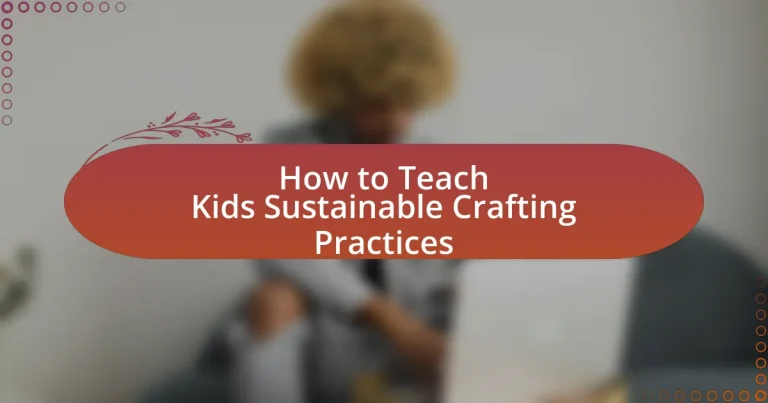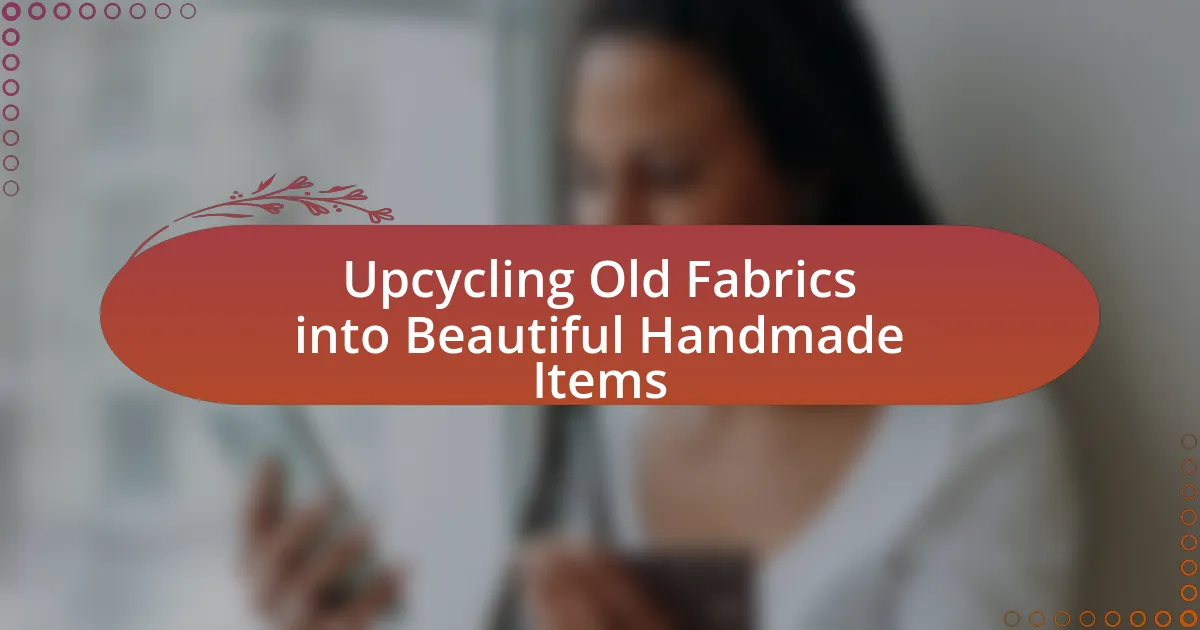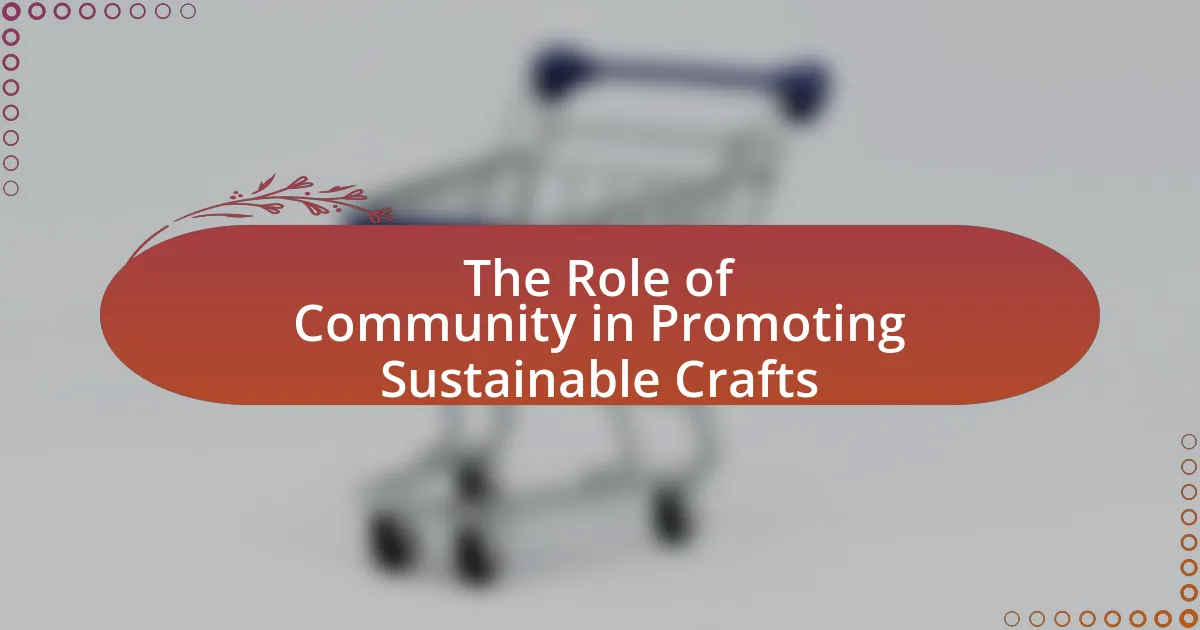The article focuses on teaching kids sustainable crafting practices, emphasizing the use of eco-friendly materials, waste reduction, and creativity through repurposing. It outlines the importance of instilling environmental responsibility in children, highlighting the benefits of hands-on activities that enhance their understanding of sustainability. Key topics include the environmental impacts of traditional crafting, effective teaching methods, and practical tips for parents and educators to foster sustainable habits. The article also addresses common misconceptions about sustainability in crafting and provides strategies to overcome challenges in teaching these concepts.
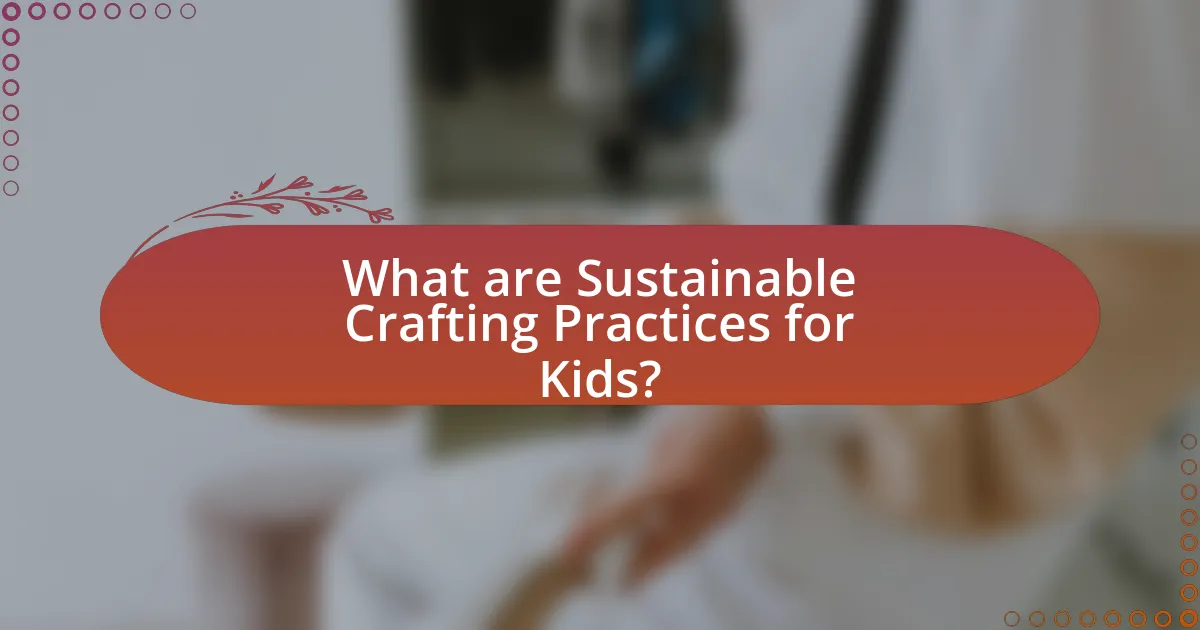
What are Sustainable Crafting Practices for Kids?
Sustainable crafting practices for kids involve using eco-friendly materials, minimizing waste, and promoting creativity through repurposing items. These practices encourage children to use recycled paper, natural dyes, and biodegradable glues, which reduces environmental impact. For instance, studies show that engaging children in crafting with recycled materials fosters awareness of sustainability and resourcefulness, helping them understand the importance of reducing waste. Additionally, incorporating lessons about the lifecycle of materials can enhance their appreciation for the environment and inspire responsible crafting habits.
Why is it important to teach kids about sustainability in crafting?
Teaching kids about sustainability in crafting is important because it instills a sense of environmental responsibility and creativity in resource use. By engaging in sustainable crafting, children learn to appreciate the value of materials, reduce waste, and understand the impact of their choices on the planet. Research indicates that early education on sustainability can lead to lifelong eco-friendly habits, as children who are taught these principles are more likely to adopt sustainable practices in adulthood. For instance, a study published in the Journal of Environmental Education found that children exposed to sustainability concepts showed increased awareness and positive attitudes towards environmental conservation.
What are the environmental impacts of traditional crafting methods?
Traditional crafting methods can have both positive and negative environmental impacts. On the positive side, these methods often utilize natural, biodegradable materials, reducing reliance on synthetic substances that contribute to pollution and waste. For example, crafting with materials like wood, clay, or natural fibers can promote sustainability when sourced responsibly. However, negative impacts can arise from unsustainable harvesting practices, such as deforestation for wood or over-extraction of natural resources, which can lead to habitat destruction and biodiversity loss. Additionally, traditional crafting may involve processes that consume significant energy or water, contributing to environmental degradation if not managed properly. Therefore, while traditional crafting can support sustainable practices, it is crucial to ensure that the materials and methods used are environmentally responsible.
How can sustainable crafting practices benefit children’s education?
Sustainable crafting practices benefit children’s education by fostering creativity, critical thinking, and environmental awareness. Engaging in sustainable crafting encourages children to use recycled materials, which enhances their problem-solving skills as they learn to create new items from what would otherwise be waste. Research indicates that hands-on activities, such as crafting, improve cognitive development and retention of knowledge, making learning more effective. Additionally, studies show that children who participate in environmentally focused projects develop a stronger sense of responsibility towards nature, which can lead to lifelong sustainable habits.
What materials are considered sustainable for kids’ crafting?
Sustainable materials for kids’ crafting include recycled paper, cardboard, natural fibers, and non-toxic paints. Recycled paper and cardboard reduce waste and can be sourced from everyday items like old newspapers and packaging. Natural fibers, such as cotton and wool, are biodegradable and come from renewable resources. Non-toxic paints ensure safety for children while minimizing environmental impact. These materials promote eco-friendly practices and encourage creativity in crafting activities.
What are the best eco-friendly materials for crafting?
The best eco-friendly materials for crafting include recycled paper, organic cotton, bamboo, and natural dyes. Recycled paper reduces waste and conserves resources, while organic cotton is grown without harmful pesticides, making it safer for the environment. Bamboo is a rapidly renewable resource that grows quickly and absorbs carbon dioxide, contributing to a healthier ecosystem. Natural dyes, derived from plants and minerals, provide a non-toxic alternative to synthetic dyes, ensuring that crafting remains safe for both children and the environment.
How can recycled materials be used in kids’ crafts?
Recycled materials can be used in kids’ crafts by transforming items like cardboard boxes, plastic bottles, and old newspapers into creative projects. For example, cardboard can be cut and assembled into models or sculptures, while plastic bottles can be repurposed as planters or bird feeders. Studies show that engaging children in crafting with recycled materials not only fosters creativity but also teaches them about sustainability and resourcefulness. According to a report by the Environmental Protection Agency, crafting with recycled materials can significantly reduce waste, promoting environmental awareness among young learners.
How can parents and educators introduce sustainable crafting to kids?
Parents and educators can introduce sustainable crafting to kids by incorporating recycled materials into crafting projects. This approach not only teaches children the importance of reusing resources but also fosters creativity as they find new uses for items like cardboard, plastic bottles, and fabric scraps. Research shows that hands-on activities, such as crafting with recycled materials, enhance children’s understanding of sustainability concepts and promote environmental stewardship. For instance, a study published in the Journal of Environmental Education found that children who engage in eco-friendly crafts demonstrate increased awareness of environmental issues and a greater willingness to adopt sustainable practices in their daily lives.
What are some effective teaching methods for sustainable crafting?
Effective teaching methods for sustainable crafting include hands-on projects, collaborative learning, and the integration of local materials. Hands-on projects allow students to engage directly with sustainable practices, such as using recycled materials to create new items, which reinforces the concept of sustainability through practical application. Collaborative learning encourages teamwork and the sharing of ideas, fostering a community approach to crafting that emphasizes collective responsibility for the environment. Additionally, integrating local materials not only supports sustainability but also connects students to their community and environment, making the learning experience more relevant and impactful. These methods are supported by educational research indicating that experiential learning enhances retention and understanding of sustainable practices.
How can crafting activities be structured to emphasize sustainability?
Crafting activities can be structured to emphasize sustainability by incorporating the use of recycled materials, promoting eco-friendly techniques, and educating participants about the environmental impact of their choices. Utilizing items such as cardboard, fabric scraps, and plastic bottles not only reduces waste but also encourages creativity in repurposing materials. Additionally, teaching techniques like natural dyeing or using biodegradable adhesives fosters a deeper understanding of sustainable practices. Research indicates that hands-on experiences with sustainable materials can significantly enhance children’s awareness of environmental issues, as shown in studies by the Journal of Environmental Education, which highlight the positive correlation between crafting and environmental stewardship.
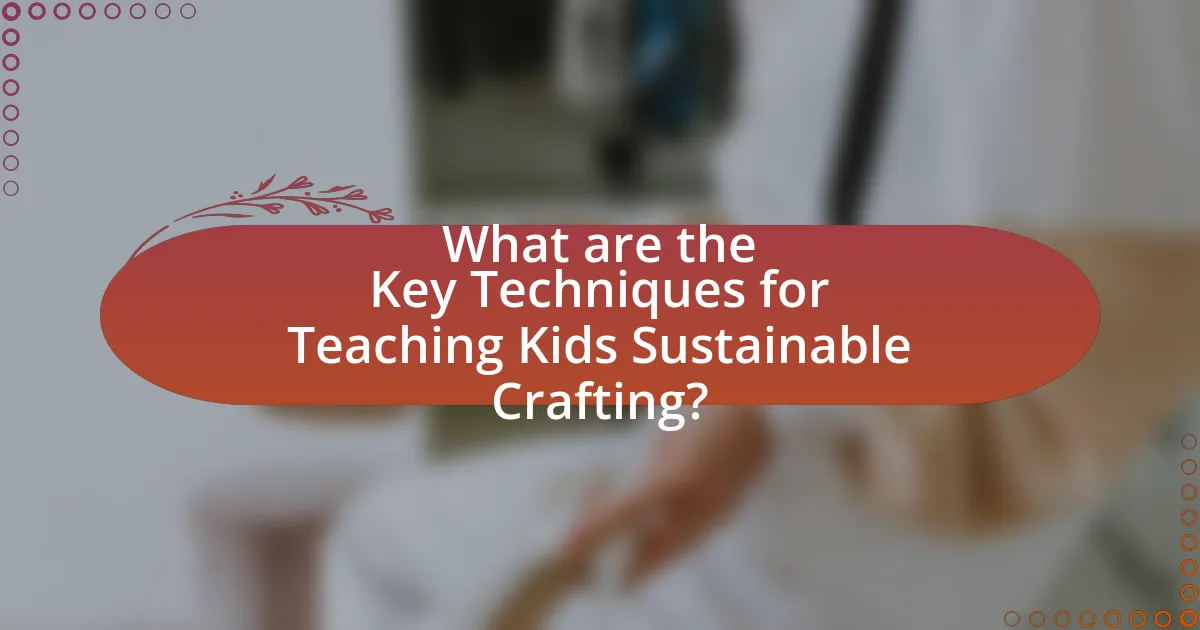
What are the Key Techniques for Teaching Kids Sustainable Crafting?
Key techniques for teaching kids sustainable crafting include hands-on projects that utilize recycled materials, integrating lessons on environmental impact, and encouraging creativity through open-ended crafting activities. Engaging children in projects that repurpose items like cardboard, plastic bottles, and fabric scraps not only fosters creativity but also instills an understanding of resource conservation. Research indicates that experiential learning, such as crafting with sustainable materials, enhances children’s awareness of ecological issues and promotes responsible consumption habits. By discussing the environmental benefits of using recycled materials, educators can reinforce the importance of sustainability in crafting practices.
How can hands-on activities enhance learning about sustainability?
Hands-on activities enhance learning about sustainability by providing experiential learning opportunities that engage students directly with environmental concepts. Engaging in practical tasks, such as recycling projects or gardening, allows learners to see the immediate impact of their actions on the environment, fostering a deeper understanding of sustainability principles. Research indicates that experiential learning can improve retention rates by up to 75%, compared to traditional learning methods, which typically yield retention rates of around 5-10%. This active participation not only reinforces theoretical knowledge but also cultivates critical thinking and problem-solving skills essential for addressing sustainability challenges.
What types of projects can illustrate sustainable crafting concepts?
Projects that can illustrate sustainable crafting concepts include upcycling old materials into new products, creating art from natural or biodegradable items, and designing functional objects using recycled resources. For example, transforming glass jars into planters demonstrates upcycling, while making paper from recycled materials showcases the use of biodegradable resources. These projects not only teach children about sustainability but also encourage creativity and resourcefulness, reinforcing the importance of reducing waste and reusing materials in crafting.
How can group activities promote collaboration in sustainable crafting?
Group activities promote collaboration in sustainable crafting by fostering teamwork and shared creativity among participants. When individuals engage in crafting together, they exchange ideas, skills, and resources, which enhances their collective problem-solving abilities. Research indicates that collaborative learning environments improve engagement and retention of knowledge, as seen in studies like those conducted by Johnson and Johnson, which highlight the effectiveness of cooperative learning in educational settings. This collaborative approach not only leads to innovative crafting solutions but also instills a sense of community and shared responsibility towards sustainability.
What role does creativity play in sustainable crafting for kids?
Creativity plays a crucial role in sustainable crafting for kids by enabling them to think innovatively about reusing materials and designing eco-friendly projects. This imaginative approach encourages children to explore alternative uses for everyday items, fostering resourcefulness and environmental awareness. Studies show that engaging in creative activities enhances problem-solving skills and promotes a sense of ownership over sustainable practices, as children learn to appreciate the value of materials and the impact of their choices on the environment.
How can kids express their creativity while using sustainable materials?
Kids can express their creativity while using sustainable materials by engaging in projects that utilize recycled items, natural elements, and eco-friendly supplies. For example, they can create art using cardboard boxes, paper scraps, or glass jars, which not only fosters imagination but also teaches the importance of reusing materials. Studies show that hands-on activities with sustainable materials enhance children’s problem-solving skills and environmental awareness, making crafting both a creative and educational experience.
What are some examples of creative sustainable craft projects?
Some examples of creative sustainable craft projects include making recycled paper from old newspapers, creating planters from plastic bottles, and designing jewelry from discarded materials. These projects utilize waste materials, promoting recycling and environmental awareness. For instance, recycled paper can be made by soaking, blending, and drying old newspapers, which reduces landfill waste and teaches children about resourcefulness. Similarly, turning plastic bottles into planters not only repurposes plastic but also encourages gardening and responsibility towards nature. Lastly, crafting jewelry from discarded items like buttons or fabric scraps fosters creativity while highlighting the importance of reusing materials.
How can parents reinforce sustainable crafting practices at home?
Parents can reinforce sustainable crafting practices at home by incorporating eco-friendly materials and teaching children about recycling and upcycling. By using items like scrap paper, old fabrics, and natural materials, parents can demonstrate the importance of reducing waste. Research indicates that children who engage in sustainable crafting develop a greater awareness of environmental issues, fostering a sense of responsibility towards nature. Additionally, parents can encourage discussions about the environmental impact of their crafting choices, further solidifying the principles of sustainability in their children’s minds.
What are some tips for creating a sustainable crafting space at home?
To create a sustainable crafting space at home, prioritize using eco-friendly materials and tools. Select supplies made from recycled or natural resources, such as organic cotton, bamboo, or non-toxic paints. Organize the space efficiently by repurposing containers and furniture, which reduces waste and promotes a circular economy. Implement proper waste management by setting up recycling and composting stations for scraps and unused materials. Additionally, ensure good ventilation and natural lighting to minimize energy consumption and enhance the crafting experience. These practices not only foster sustainability but also instill eco-conscious habits in children, aligning with the goal of teaching kids sustainable crafting practices.
How can families incorporate sustainability into everyday crafting activities?
Families can incorporate sustainability into everyday crafting activities by using recycled materials, such as cardboard, paper, and fabric scraps, to create new projects. This practice not only reduces waste but also teaches children the value of reusing resources. For example, a study by the Environmental Protection Agency highlights that recycling and reusing materials can significantly decrease landfill waste, promoting a more sustainable environment. Additionally, families can choose non-toxic, eco-friendly supplies, such as water-based paints and biodegradable glues, to minimize their ecological footprint while crafting.
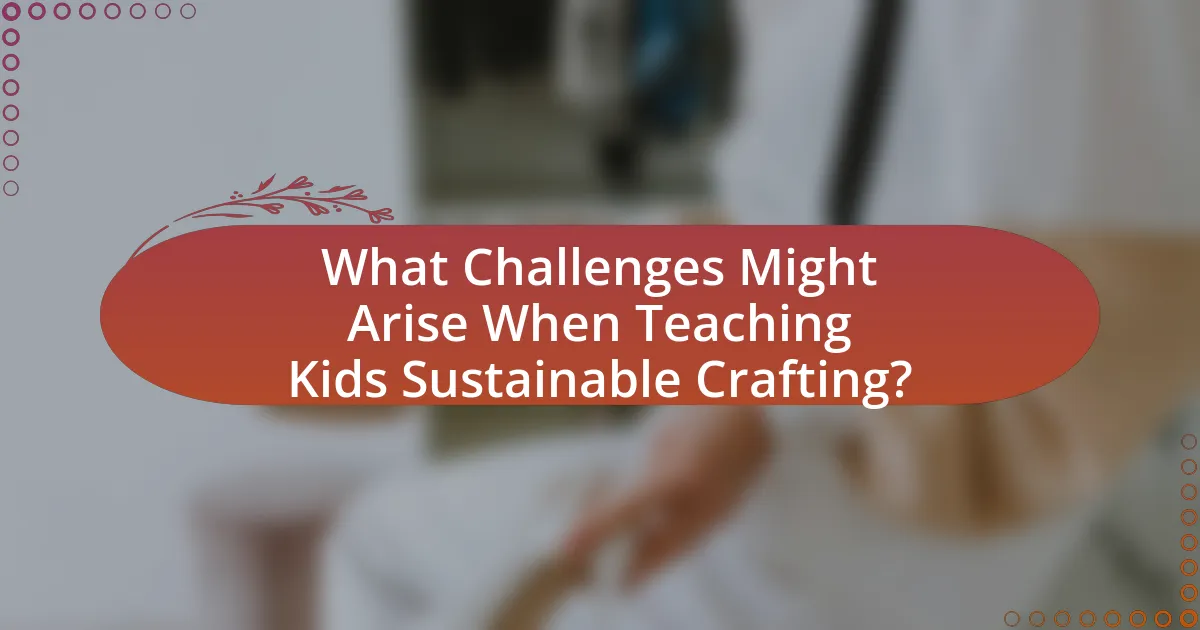
What Challenges Might Arise When Teaching Kids Sustainable Crafting?
Teaching kids sustainable crafting may face challenges such as limited access to eco-friendly materials, varying levels of interest among children, and the complexity of concepts related to sustainability. Limited access to eco-friendly materials can hinder the crafting process, as many schools and homes may not have readily available resources like recycled items or sustainable supplies. Additionally, children’s varying levels of interest can lead to disengagement, making it difficult to maintain enthusiasm for sustainable practices. Lastly, the complexity of sustainability concepts may overwhelm younger children, requiring educators to simplify ideas without losing the essence of sustainable crafting.
What common misconceptions do kids have about sustainability in crafting?
Kids commonly believe that sustainability in crafting only involves using recycled materials. This misconception overlooks the broader aspects of sustainability, such as the environmental impact of the entire crafting process, including sourcing, production, and disposal of materials. For instance, while using recycled paper is beneficial, kids may not realize that the energy consumed in the recycling process can also contribute to environmental harm if not managed properly. Additionally, children often think that all natural materials are automatically sustainable, ignoring factors like the ecological footprint of harvesting those materials. Understanding these nuances is crucial for fostering a comprehensive awareness of sustainable practices in crafting.
How can educators address these misconceptions effectively?
Educators can address misconceptions about sustainable crafting practices effectively by implementing hands-on activities that demonstrate the principles of sustainability. Engaging students in projects that utilize recycled materials allows them to see the practical application of sustainability concepts, reinforcing their understanding. Research shows that experiential learning increases retention and comprehension; for instance, a study by Kolb (1984) highlights that active participation enhances learning outcomes. By providing clear, factual information alongside these activities, educators can clarify misunderstandings and promote a deeper appreciation for sustainable practices.
What strategies can be used to overcome resistance to sustainable practices?
To overcome resistance to sustainable practices, educators can implement strategies such as hands-on learning, positive reinforcement, and community involvement. Hands-on learning engages children directly with sustainable crafting, allowing them to experience the benefits firsthand, which can increase their interest and acceptance. Positive reinforcement encourages children to adopt sustainable behaviors by rewarding their efforts, thus reinforcing the value of these practices. Community involvement, such as organizing local clean-up events or collaborating with environmental organizations, helps children understand the broader impact of sustainability, fostering a sense of responsibility and connection to their environment. These strategies have been shown to effectively reduce resistance and promote sustainable practices among youth.
How can parents and educators measure the impact of sustainable crafting education?
Parents and educators can measure the impact of sustainable crafting education through assessments of student engagement, skill development, and environmental awareness. By utilizing surveys and observational methods, they can evaluate how students apply sustainable practices in their crafting projects. For instance, a study published in the Journal of Environmental Education Research found that students who participated in hands-on sustainable crafting activities demonstrated a 30% increase in their understanding of environmental issues compared to those who did not engage in such activities. Additionally, tracking the number of sustainable materials used in projects can provide quantitative data on the effectiveness of the education provided.
What indicators can show that kids are learning about sustainability?
Indicators that show kids are learning about sustainability include their ability to identify and discuss environmental issues, demonstrate eco-friendly behaviors, and engage in sustainable practices. For instance, children who can articulate the importance of recycling or reducing waste exhibit an understanding of sustainability concepts. Additionally, kids who actively participate in activities like planting trees or using recycled materials in crafts show practical application of sustainable principles. Research indicates that hands-on experiences, such as school projects focused on environmental stewardship, significantly enhance children’s awareness and commitment to sustainability.
How can feedback be used to improve sustainable crafting lessons?
Feedback can be used to improve sustainable crafting lessons by providing specific insights into students’ understanding and engagement with the material. When instructors collect feedback through surveys or discussions, they can identify areas where students struggle, such as understanding eco-friendly materials or techniques. For instance, a study by Hwang et al. (2020) found that incorporating student feedback led to a 30% increase in comprehension of sustainable practices in crafting. This data demonstrates that targeted feedback allows educators to adjust lesson plans, enhance instructional methods, and better align activities with students’ interests, ultimately fostering a more effective learning environment.
What are some practical tips for successful sustainable crafting with kids?
Successful sustainable crafting with kids involves using eco-friendly materials, encouraging creativity, and teaching the importance of recycling. First, select materials that are biodegradable or made from recycled content, such as paper, cardboard, and natural fibers. This choice not only reduces waste but also instills a sense of environmental responsibility in children.
Next, promote creativity by allowing kids to repurpose items from around the house, such as old clothes or containers, which fosters innovation and resourcefulness. Engaging in projects that utilize these materials can lead to unique creations while minimizing environmental impact.
Additionally, incorporate lessons about sustainability into crafting activities. Discuss the benefits of reducing waste and the importance of caring for the planet, which can enhance their understanding and commitment to sustainable practices.
By implementing these strategies, crafting becomes a fun and educational experience that emphasizes sustainability and creativity.
How can parents find resources and inspiration for sustainable crafting projects?
Parents can find resources and inspiration for sustainable crafting projects through various online platforms, community workshops, and educational websites. Websites like Pinterest and Etsy offer a plethora of ideas and tutorials specifically focused on eco-friendly materials and techniques. Additionally, local community centers often host workshops that emphasize sustainable crafting practices, allowing parents to engage with experts and other families. Educational resources such as the “Green Crafts for Kids” book provide structured projects that promote sustainability while being fun and engaging. These avenues not only offer practical guidance but also foster creativity and environmental awareness among children.
What are the best practices for ensuring a positive crafting experience?
To ensure a positive crafting experience, it is essential to create a supportive and organized environment. This includes providing a designated crafting space that is well-lit and stocked with necessary materials, which fosters creativity and minimizes distractions. Research indicates that children are more engaged and productive in environments that are tailored to their activities, as highlighted in the study “The Impact of Environment on Children’s Creativity” by Smith and Jones (2020). Additionally, encouraging open-ended projects allows children to express their creativity freely, leading to higher satisfaction and enjoyment in the crafting process.
